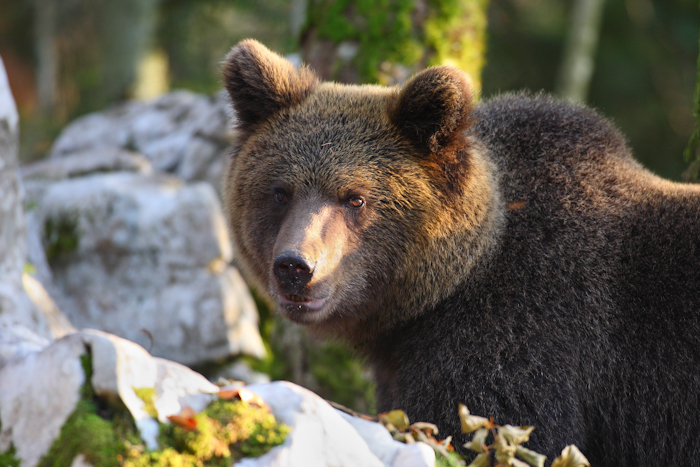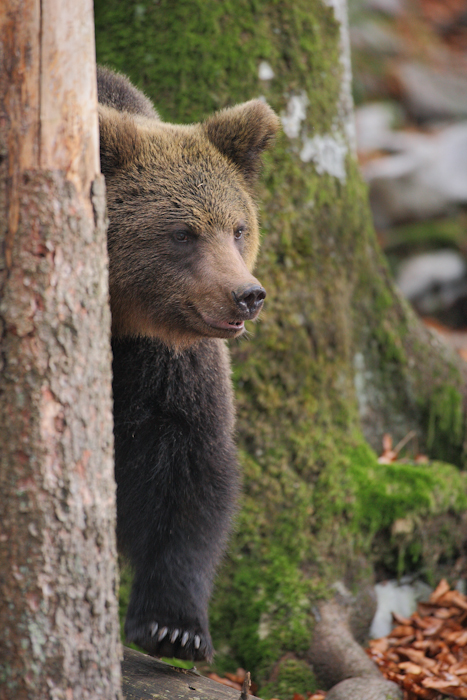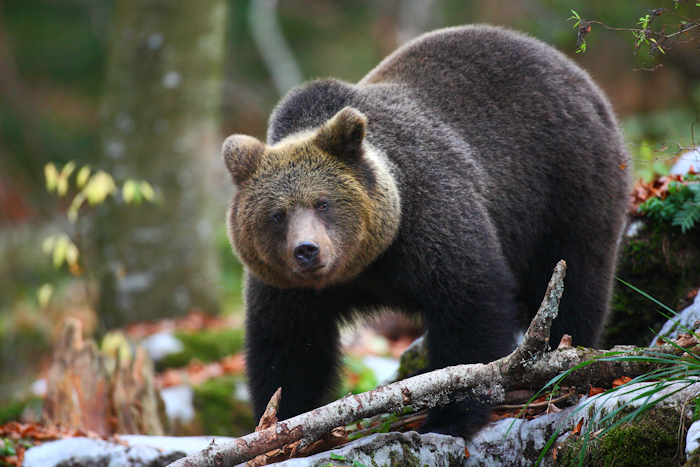The bear is a solitary animal, and male bears tend to avoid each other. They indicate their presence by scratching trees and leaving scent markings.
In one bear territory, several females may live, but a male only encounters a female during the mating season in late spring.
The female typically gives birth around the New Year, usually to 1 to 4 cubs. Since bear cubs are born during a time when bears do not eat, they are very small at birth. They are born hairless and toothless. The mother bear is very protective of her offspring. Cubs stay with mother bear for two years and during this period mother can be very dangerous and aggressive.

Brown bear (Ursus arctos)
| Size |
|
| Weight |
|
| Diet |
|
| Habitat |
|
| Kingdom |
|
| Phylum |
|
| Class |
|
| Order |
|
| Family |
|
| Genus |
|
| Species |
|
| Subspecies |
|
Bears often visit beehives, where they indulge in bee larvae and, of course, honey. Because they love honey, all Slavic languages have derived their name from it—'medojed,' which translates to 'honey-eater'.
In spring and summer, bears eat grass, forest fruits, berries, and herbs. In autumn, they consume acorns and chestnuts, and they also indulge in carrion and the larvae of ants and wasps. Less grequently, bears will hunt roe deer and red deer offsprings. They strike their prey with a powerful paw and bite at the neck. They sometimes also attack domestic animals. It is well-known that bears have a sweet tooth, particularly for honey. This is reflected in their name in all Slavic languages, derived from 'honey-eater'—medojed.
Before winter, bears feed intensively to build up their fat reserves. It is a common misconception that bears hibernate throughout the winter.
Bears drowse during the winter and often leave their den.
Well, even when choosing a den, the giant mammal is not picky. It may use smaller rock holes and often digs its own den. If the ground is not suitable for digging, it rests in dense spruce forests.
Brown bears are widely distributed and inhabit various environments. They originally occupied all of Europe, large parts of Asia, and North America, but humans have eradicated them in many areas. As a result, the bear is listed as an endangered species.
Some estimates suggest that there are more than 1000 bears living in Slovenian forests. They can be found everywhere in Slovenia, most of them in the Kočevje region. Between five and ten brown bears are more or less permanent residents of the Triglav National Park. In the Triglav National Park, there are bears in Pokljuka, Mežakla, Lower Bohinj Mountains, Trenta and area of Tolmin.


In areas inhabited by bears, we must make our presence known and follow some guidelines:
- When visiting the forest, be loud enough to avoid surprising a bear. Make noise to alert them to your presence!
- Always keep your dog on a leash.
- If you spot a bear, never approach or disturb it.
- Never feed bears.
- Do not approach a feeding bear.
- Do not leave food scraps in the forest or at the edge of the forest or near mountain huts.
- Do not approach a bear's den, and do not attempt to enter it.
You can learn more about bears, lynxes, and wolves through educational games HERE.
DO YOU KNOW?
- Bears can run up to 60 km/h.
- The bear is a very popular plush toy. It was first made simultaneously in Germany and the United States in 1902.
- Two constellations in the northern hemisphere, the Great Bear and the Little Bear, are also named after bears.

